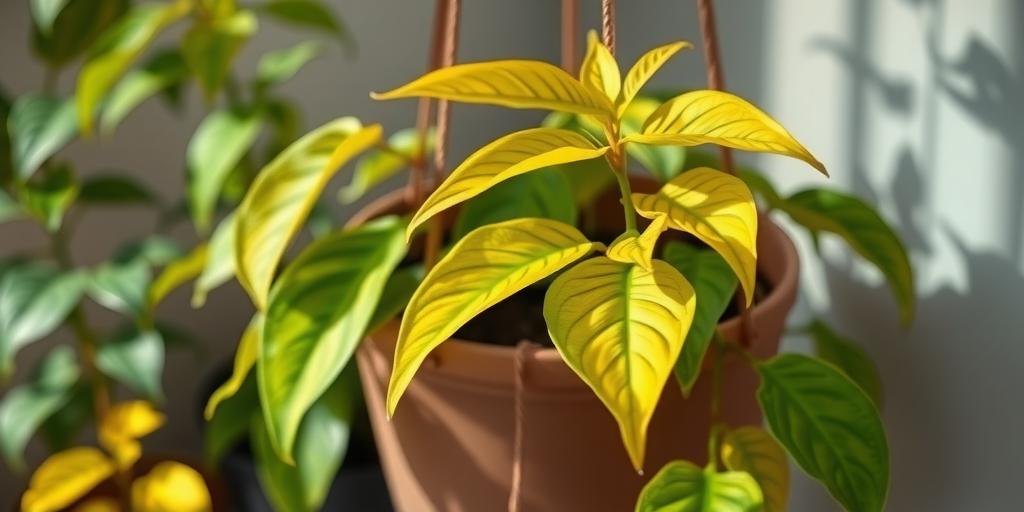
Why Are My Hanging Plant Leaves Turning Yellow? Causes & Solutions (2025)
Wondering why your hanging plant leaves are turning yellow? Discover the top causes—from overwatering to nutrient deficiencies—and learn actionable solutions to revive your plants!
Introduction
Nothing ruins the lush beauty of hanging plants faster than yellowing leaves! If your once-vibrant greenery is looking sickly, don’t panic—yellow leaves are a common issue with multiple fixes. Whether it’s due to improper watering, poor lighting, or pests, we’ll break down the reasons and provide easy solutions. Did you know that overwatering is the #1 cause of yellow leaves? Let’s dive in and bring your plants back to life!
🌿 Overwatering or Poor Drainage
You know that feeling when you love your hanging plants too much? Yeah, overwatering is the plant-parent equivalent of force-feeding your kids. If the soil stays soggy for days, your plant’s roots can’t breathe—they start rotting, and the leaves turn yellow as a distress signal.
Signs to watch for:
-
Soil that feels wet long after watering
-
Wilting leaves (ironic, since it looks thirsty!)
-
A musty smell or black, mushy roots (root rot alert)
How to fix it:
-
Check before you water: Stick your finger an inch into the soil—if it’s damp, hold off.
-
Drainage is key: Use pots with holes and add perlite or orchid bark to the soil mix.
-
Adjust your routine: Some plants (like pothos) prefer drying out between drinks; others (ferns, I’m looking at you) like consistency.
☀️ Insufficient or Excessive Light
Plants are Goldilocks—they want light that’s just right. Too little, and they fade; too much, and they fry.
Signs to watch for:
-
Low light: Pale, stretched-out leaves, slow growth.
-
Too much light: Scorched brown patches or crispy edges.
How to fix it:
-
Bright, indirect light is the sweet spot. Think near an east-facing window or behind a sheer curtain.
-
Rotate your plant occasionally so all sides get even exposure.
-
Artificial help: If your space is dim, a grow light can work wonders (just don’t blast it 24/7).
🌱 Nutrient Deficiencies
Plants can’t order takeout, so when they’re hungry, their leaves yell(ow) for help. Nitrogen deficiency is a common culprit—older leaves fade first while new growth stays green.
Signs to watch for:
-
Yellowing between veins (like a reverse skeleton)
-
Weak, stunted growth
How to fix it:
-
Fertilize wisely: A balanced liquid fertilizer (e.g., 10-10-10) every 4–6 weeks during growing season.
-
Organic boost: Compost or worm castings gently feed the soil.
-
Foliar spray: For a quick fix, dilute fertilizer and mist leaves (just avoid direct sun afterward).
🐜 Pest Infestations
Aphids, spider mites, and mealybugs treat your plant like an all-you-can-eat buffet—and leave yellowing, sticky leaves behind.
Signs to watch for:
-
Tiny bugs (check under leaves!)
-
Sticky “honeydew” or fine webbing
-
Distorted, speckled leaves
How to fix it:
-
Blast them off with water or wipe leaves with soapy water.
-
Neem oil or insecticidal soap (spray weekly until pests are gone).
-
Call in reinforcements: Ladybugs devour aphids—nature’s pest control!
💧 Underwatering or Low Humidity
Neglect isn’t cool, but some plants (like succulents) prefer tough love. Others (looking at you, ferns) throw a fit if the air’s too dry.
Signs to watch for:
-
Crispy, curled leaves
-
Soil shrinking away from the pot’s edges
How to fix it:
-
Water deeply until it runs out the drainage holes, then let the top inch dry out.
-
Humidity hacks: Group plants together, mist them, or set pots on a tray of pebbles and water.
🌡️ Temperature Stress
Plants hate drama—sudden chills, blasting AC, or radiator heatwaves can trigger leaf drop or yellowing.
Signs to watch for:
-
Drooping or sudden leaf loss
-
Brown edges (often from dry, hot air)
How to fix it:
-
Keep it steady: Most houseplants like 65–75°F (18–24°C).
-
Draft-proof: Move plants away from vents, doors, or cold windows in winter.
🌿 Natural Aging Process
Sometimes, yellow leaves just mean your plant is shedding its older, less efficient parts—like swapping out last season’s wardrobe.
Signs to watch for:
-
Only the oldest leaves (bottom of the plant) yellowing
-
New growth looks healthy
How to fix it:
-
Prune with clean scissors to redirect energy to new leaves.
-
Don’t panic! It’s part of the plant’s life cycle.
Pro tip: Diagnosing yellow leaves is like playing plant detective—check the pattern (all over? just tips?) and context (watering habits, light changes) to crack the case!
Conclusion
Yellow leaves on hanging plants don’t have to spell disaster! By identifying the root cause—whether it’s watering habits, lighting, or pests—you can take quick action to restore your plant’s health. Remember: consistent care is key. Check your plants regularly, adjust their environment as needed, and don’t hesitate to experiment with fixes. Ready to bring back the green? Your thriving hanging plants are just a few adjustments away!
